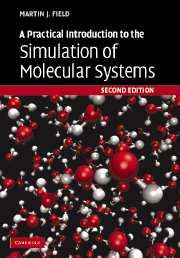Book contents
- Frontmatter
- Contents
- Preface to the first edition
- Preface to the second edition
- 1 Preliminaries
- 2 Chemical models and representations
- 3 Coordinates and coordinate manipulations
- 4 Quantum chemical models
- 5 Molecular mechanics
- 6 Hybrid potentials
- 7 Finding stationary points and reaction paths on potential energy surfaces
- 8 Normal mode analysis
- 9 Molecular dynamics simulations I
- 10 More on non-bonding interactions
- 11 Molecular dynamics simulations II
- 12 Monte Carlo simulations
- Appendix 1 The pDynamo library
- Appendix 2 Mathematical appendix
- Appendix 3 Solvent boxes and solvated molecules
- Bibliography
- Author index
- Subject index
4 - Quantum chemical models
Published online by Cambridge University Press: 03 December 2009
- Frontmatter
- Contents
- Preface to the first edition
- Preface to the second edition
- 1 Preliminaries
- 2 Chemical models and representations
- 3 Coordinates and coordinate manipulations
- 4 Quantum chemical models
- 5 Molecular mechanics
- 6 Hybrid potentials
- 7 Finding stationary points and reaction paths on potential energy surfaces
- 8 Normal mode analysis
- 9 Molecular dynamics simulations I
- 10 More on non-bonding interactions
- 11 Molecular dynamics simulations II
- 12 Monte Carlo simulations
- Appendix 1 The pDynamo library
- Appendix 2 Mathematical appendix
- Appendix 3 Solvent boxes and solvated molecules
- Bibliography
- Author index
- Subject index
Summary
Introduction
In the last chapter we dealt with how to manipulate a set of coordinates and how to compare the structures defined by two sets of coordinates. This is useful for distinguishing between two different structures but it gives little indication regarding which structure is the more probable; i.e. which structure is most likely to be found experimentally. To do this, it is necessary to be able to evaluate the intrinsic stability of a structure, which is determined by its potential energy. The differences between the energies of different structures, their relative energies, will then determine which structure is the more stable and, hence, which structure is most likely to be observed.
This chapter starts off by giving an overview of the various strategies that are available for calculating the potential energy of molecular systems and then goes on to describe a specific class of techniques based upon the application of the theory of quantum mechanics to chemical systems.
The Born–Oppenheimer approximation
Quantum mechanics was developed during the first decades of the twentieth century as a result of shortcomings in the existing classical mechanics and, as far as is known, it is adequate to explain all atomic and molecular phenomena. In an oft-quoted, but nevertheless pertinent, remark, P. A. M. Dirac, one of the founders of quantum mechanics, said in 1929:
The underlying physical laws necessary for the mathematical theory of a large part of physics and the whole of chemistry are thus completely known, and the difficulty is only that the exact application of these laws leads to equations much too complicated to be soluble. It therefore becomes desirable that approximate practical methods of applying quantum mechanics should be developed, which can lead to an explanation of the main features of complex atomic systems without too much computation.
- Type
- Chapter
- Information
- Publisher: Cambridge University PressPrint publication year: 2007

